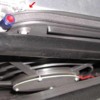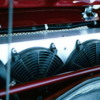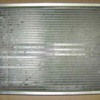3
George,
Here is a link to Mike D's article on Meriah fans.
I am not good at resizing so hopefully you can and post.
Jeff
The Pantera Place - Meriah Fans
Here is a link to Mike D's article on Meriah fans.
I am not good at resizing so hopefully you can and post.
Jeff
The Pantera Place - Meriah Fans
Attachments
Here is a shot of the Ron Davis radiator in my Group 4 car. Not a good shot, but too lazy to get the car out of the stacker right now to get a good photo. Dude I got the car from said he had it custom made with Ron, but who knows if that is right or not. It is thicker than the Fluidline I have in my red 5S and has a hose at the top too. Will take photos & measure thickness later when I am sober.
Attachments
Does 200,
I just pulled the radiator on my 74 a few days ago to either replace it or have it rebuilt. I noticed in your picture that the top radiator hose is on the driver’s side of the car where both of mine are on the passenger side.
Is your lower radiator hose also on the driver’s side or do you know if different years of Panteras have different hose routings?
Thanks.
I just pulled the radiator on my 74 a few days ago to either replace it or have it rebuilt. I noticed in your picture that the top radiator hose is on the driver’s side of the car where both of mine are on the passenger side.
Is your lower radiator hose also on the driver’s side or do you know if different years of Panteras have different hose routings?
Thanks.
quote:I noticed in your picture that the top radiator hose is on the driver’s side of the car where both of mine are on the passenger side.
That is likely a triple pass radiator.
Quella sold those back in the mid-90's, made by Ron Davis.
Here is a shot of mine I just took out and sent to Davis so they can build me a new one.
Larry
Attachments
Hello
I'm on the way to restore my '72 Pantera, then I have some questions for you ...
Here are the Pressure tank and expansion tank in the car (?)
I've noticed that the caps are from BMW cars ??
Yes, I have to clean and improve that, but the car was running rather cool ...
Did you ever see this setup ?
thanks a lot
regards from France
Philippe



I'm on the way to restore my '72 Pantera, then I have some questions for you ...
Here are the Pressure tank and expansion tank in the car (?)
I've noticed that the caps are from BMW cars ??
Yes, I have to clean and improve that, but the car was running rather cool ...
Did you ever see this setup ?
thanks a lot
regards from France
Philippe



The radiators that Pantera Performance/Ron Davis sell now are single pass radiators. Many years ago, Pantera Performance sold a triple pass radiator (that was made by Ron Davis to PPC's specs) but soon discovered the single pass version works better, due to increased flow/lower resistance to flow. I don't believe Ron Davis ever sold a triple pass radiator for any application.
quote:Originally posted by DOES 200:
Here is a shot of the Ron Davis radiator in my Group 4 car. Not a good shot, but too lazy to get the car out of the stacker right now to get a good photo. Dude I got the car from said he had it custom made with Ron, but who knows if that is right or not. It is thicker than the Fluidline I have in my red 5S and has a hose at the top too. Will take photos & measure thickness later when I am sober.
I have one just like yours. Pantera Performance was selling the triple pass ones years ago. Ron Davis in Phoenix was building them for Dennis. It is a very good radiator.
On the subject of radiators and cooling for a daily driver 420HP Pantera... I have done the swirl tank mods as shown in this thread ( VENTING SYSTEM ), below is my old post after I unwrapped my new radiator,single 16" spal sucker, I have the flow kooler anti cavitation pump, no heater, and SS tubes. I can report my car runs about 175 and even on the hottest day in central Florida, with my A/C blowing ice cold, it still runs under 188, I seldom if ever see temps above 185. In short, these mods will resolve all cooling issues.
Photo of my radiator
http://pantera.infopop.cc/eve/...360079675#9360079675
Photo of my radiator
http://pantera.infopop.cc/eve/...360079675#9360079675
FWIW, Ron Davis himself gave a nice talk on radiators at the POCA Fun Rally Tech Session. One of the questions regarded single pass vs double pass radiators. Mr. Davis said a double- pass rad as used on Panteras usually gave a 17 degree F temp drop relative to a single-pass. This is what Team manager Carroll Smith also found with road racing GT-40s back in the day. Stating the obvious, Panteras cannot afford to give away 17 degrees of cooling, so always use at least a double pass! A triple pass gains a little more over a double pass, but not another 17 degrees- diminishing returns lowers any further temp drop to more like 5 or 6 degrees.
The main advantage of aluminum rads is 'as good' cooling as a copper/brass rad and about 1/4 the weight. My stock rad (probably with some hard water scale buildup inside) weighed 64 lbs, while a custom core copper/brass weighed 45 lbs. The Fluidyne (from PIM 10 years ago) weighed 17 lbs.
All three cooled adequately but the Fluidyne, because of it's much larger internal passages and the fact that it holds a little more coolant, dropped my cruising temps by 15 degrees with no other changes; YMMD.
The main advantage of aluminum rads is 'as good' cooling as a copper/brass rad and about 1/4 the weight. My stock rad (probably with some hard water scale buildup inside) weighed 64 lbs, while a custom core copper/brass weighed 45 lbs. The Fluidyne (from PIM 10 years ago) weighed 17 lbs.
All three cooled adequately but the Fluidyne, because of it's much larger internal passages and the fact that it holds a little more coolant, dropped my cruising temps by 15 degrees with no other changes; YMMD.
Ron Davis's remark that you reduce cooling temps by 17 degrees with a double pass over a single pass is inaccurate. I have installed, helped install and observed many Pantera cooling systems in hot and humid Texas. In these applications we have run both double pass and single pass radiators. While both work well, back to back testing gives the nod to single pass. In our applications utilyzing by-pass thermostats, both types of radiators will cool adequately at highway speeds to hold temps at the opening temps of the thermostat. If you sensor for your fans trigger them at a temp above your thermostat opening temp, the fans will not engage. Certainly no 17 degree temperature difference there.
The nod goes to single pass on around town driving due to the shorter recovery time for fans to switch off after bringing down coolant temps. The same situation at idle.
The 17 degree difference statement is about as accurate as, another I hear, stating Watter Wetter will reduce coolant temps by 15 degrees. I don't think so.
For more info on employing a bypass thermostat, try this website: http://www.spacecitypanteras.c...Cooling-JTaphorn.pdf The article deserves updating as our latest testing proves that a single degas bottle that is large enough works great; there is no need for a separate expansion tank. This simplifies the desiagn and reduces space utilization in the engine compartment.
The nod goes to single pass on around town driving due to the shorter recovery time for fans to switch off after bringing down coolant temps. The same situation at idle.
The 17 degree difference statement is about as accurate as, another I hear, stating Watter Wetter will reduce coolant temps by 15 degrees. I don't think so.
For more info on employing a bypass thermostat, try this website: http://www.spacecitypanteras.c...Cooling-JTaphorn.pdf The article deserves updating as our latest testing proves that a single degas bottle that is large enough works great; there is no need for a separate expansion tank. This simplifies the desiagn and reduces space utilization in the engine compartment.
John, I also thought it was odd that Ron Davis would say that, since the "ultimate" Pantera rad. he helped Dennis Q. develop is a single pass. I bought my rad from Ron Davis and when the question of "passes" came up, they completely dismissed any thought I had with regard to a multi-pass rad.
That being said, I believe Jack when he says Ron Davis said a two pass rad would lower coolant temps by 17 degrees. Perhaps he was referring to rows of coolant tubes in the core and said "passes" by mistake.
This is taken from the Stewart Components web site:
Radiators:
The most important criteria for any radiator is it's surface area. The thickness of the core is increased only after the surface area is maximized. Adding thickness to a radiator does not increase it's efficiency the same extent as surface area, but in no case will additional thickness alone decrease the efficiency.
The radiator becomes less efficient as the coolant outlet temperature approaches ambient. Therefore, a low flow rate keeps the coolant in the radiator longer. The longer the coolant stays in the radiator the lower the efficiency of the radiator.
When baffles are inserted in the tanks to force the water to go through the radiator twice, the water spends the same amount of time in the radiator but must go twice the distance.
That being said, I believe Jack when he says Ron Davis said a two pass rad would lower coolant temps by 17 degrees. Perhaps he was referring to rows of coolant tubes in the core and said "passes" by mistake.
This is taken from the Stewart Components web site:
Radiators:
The most important criteria for any radiator is it's surface area. The thickness of the core is increased only after the surface area is maximized. Adding thickness to a radiator does not increase it's efficiency the same extent as surface area, but in no case will additional thickness alone decrease the efficiency.
The radiator becomes less efficient as the coolant outlet temperature approaches ambient. Therefore, a low flow rate keeps the coolant in the radiator longer. The longer the coolant stays in the radiator the lower the efficiency of the radiator.
When baffles are inserted in the tanks to force the water to go through the radiator twice, the water spends the same amount of time in the radiator but must go twice the distance.
I have the "Hall " radiator and have had it since 1997, I had it boiled out and re-brazed a year ago, my car has never overheated, I recently replaced the monster German fans ( 6lbs ea.)with high speed be cool fans that were easily fabricated to fit, the weigh about 2lbs the new fans cool better, draw less amps and have a net weight savings of 8 lbs.
quote:Originally posted by David B:
Okay, let's hear some experienced voices.
If you had to change your rad now, what would you go with - and why?
1 - OEM
2 - Fluidyne
3 - Hall
4 - other?
The Fluidyne is a lighter radiator. That is it's only advantage.
The Hall "phoenix" is brass and is thicker then the OEM and also heavier.
The OEM dual pass is a good radiator.
The brass radiators are repairable almost infinitely. The Aluminum is not.
From what I am hearing there are more then a few of the Fluidyne's that need repair within a few years?
For most people the stock OEM is the way to go. That's what I am using, and it works fine.
The Hall "phoenix" is brass and is thicker then the OEM and also heavier.
The OEM dual pass is a good radiator.
The brass radiators are repairable almost infinitely. The Aluminum is not.
From what I am hearing there are more then a few of the Fluidyne's that need repair within a few years?
For most people the stock OEM is the way to go. That's what I am using, and it works fine.
I'm still running the stock radiator; it's never been removed from the car since it was installed at the factory 40 years ago. Try that with an aluminum one. My system is stock except for a better dual pusher fan set up. Never any overheating problems at all.
I'm meticulous about changing all fluids every year. My Brake Master Cylinder, Clutch Master Cylinder and Clutch Slave Cylinder all made it 39 years. I'm still running the original 40 year old Brake Calipers and Water Pump.
Change your fluids annually!!
I'm meticulous about changing all fluids every year. My Brake Master Cylinder, Clutch Master Cylinder and Clutch Slave Cylinder all made it 39 years. I'm still running the original 40 year old Brake Calipers and Water Pump.
Change your fluids annually!!
quote:Originally posted by 1973 Pantera:
I'm still running the stock radiator; it's never been removed from the car since it was installed at the factory 40 years ago. Try that with an aluminum one. My system is stock except for a better dual pusher fan set up. Never any overheating problems at all.
I'm meticulous about changing all fluids every year. My Brake Master Cylinder, Clutch Master Cylinder and Clutch Slave Cylinder all made it 39 years. I'm still running the original 40 year old Brake Calipers and Water Pump.
Change your fluids annually!!
What type of fan did you upgrade to? I'm considering rebuilding my OEM rad that I just pulled out of my 1974 Pantera. I've heard too many stories about the Fluidyne leaking after only a few years...anxious to hear about yours...
John in Fort Erie Canada
A couple of years ago bought a brass/copper new Hall radiator. I showed it to an old school
3 generation radiator shop. They were blown away by the quality. Said it was worth every penny. Fit was perfect, no modifications required.
3 generation radiator shop. They were blown away by the quality. Said it was worth every penny. Fit was perfect, no modifications required.
quote:Originally posted by IndyDave:
... They were blown away by the quality. Said it was worth every penny ...
It is a nice radiator
quote:What type of fan did you upgrade to? I'm considering rebuilding my OEM rad that I just pulled out of my 1974 Pantera. I've heard too many stories about the Fluidyne leaking after only a few years...anxious to hear about yours...
John in Fort Erie Canada
I used a Flex-A-Lite FLX-240. It's a pusher fan setup that installs in front of the radiator. I believe the new part # is FLX-440; but double check to make sure. They blow a total of 2500 CFM.
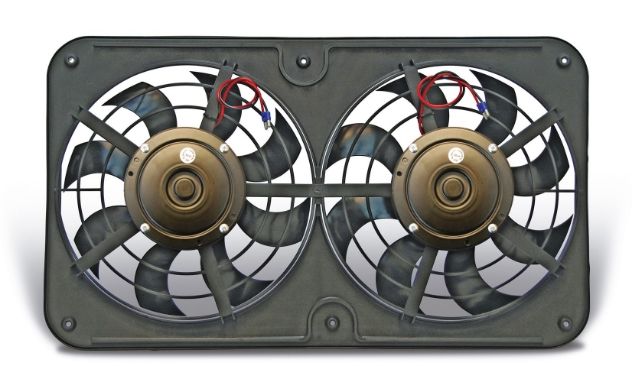
The stock Pantera fans blow a total of just 600 CFM; it's quite an improvement.
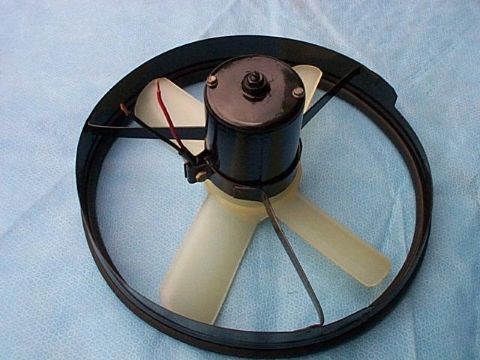
The fans sit in a nice shroud with a rubber gasket that cushions the shroud against the radiator. Just remove your stock fans and it slips in like it was made for it. No need to fasten it to anything, just slide it in and it wedges nicely into place. The very top of the shroud will be about 3/16 of an inch above the radiator when it's in place, but it's fine & the metal cover that covers the fans (the one with the 2 Phillips head screws that covers the top front of the radiator) fits with no problem. The bullet end wire connectors even plug into the factory connectors.
Is there a way to recognise from a picture a pre-74 radiator with vertical baffle from a later design with newer horizontal divider?
-Sami
-Sami
Add Reply
Sign In To Reply


